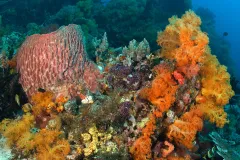Making Science Sing: The Longest Time (Coral Triangle Edition)

How do you make science sing? Just ask a couple of female scientists to sing about their research interests and their passion is quickly conveyed in a quirky little tune. Informative, inspiring, and a little bit silly are all adjectives that aptly describe this music video performed and produced by a group of female graduate students from UCLA’s Barber Lab. Set to Billy Joel’s “The Longest Time,” this little ditty does a fabulous job of describing biodiversity of the Coral Triangle and these student’s research and passion for studying it.
The video started getting more attention this week as a positive way to portray women in science, following a media campaign by the European Union that has received a firestorm of criticism.
In response to the EU’s PSA, “Science: It’s a Girl Thing,” scientists such as Neil deGrasse Tyson, an American astrophysicist and science communicator, have praised the Barber Lab quartet for marketing science to girls. The video has even caught the attention of the song’s original artist, Billy Joel, who featured it on his own website.
The female scientists in this video are all members of the Barber Lab and Indonesian Biodiversity Research Center (IBRC). The Barber Lab and IBRC program are working to understand the processes creating and maintaining biological diversity in the region, while building the capacity of researchers and students to contribute to local conservation efforts in the Coral Triangle- one of the most threatened, yet understudied ecosystems in the world.
For more information please visit www.IBRCBali.org, or contact the quartet directly.

